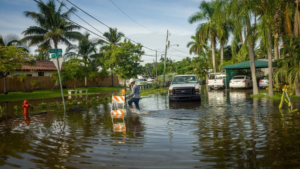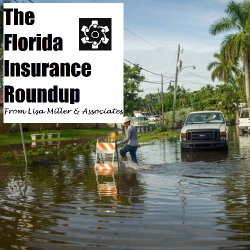Broward’s 21-mile inland storm surge

Ft. Lauderdale tidal flooding, September 2015. Courtesy, Paul Krashefski/Broward County
High-risk flood zones are expanding this year along significant stretches of Florida’s coastline. In Broward County, nearly 90,000 properties have been moved into a FEMA flood zone. But 80,000 of them were in such a zone prior to ten years ago, when FEMA moved them out – only to add them back in this year. Many will now have to purchase flood insurance. When I first read about the story in the South Florida Sen Sentinel, I was left wondering ‘How do you go from being in a flood zone, then not being in one, and then ten years later back into one?’
So I asked that very question of Carlos Adorisio, Floodplain Manager for the unincorporated area of Broward County. He and I were joined by Ron Hurtibise who broke the Sun Sentinel story and Ron’s wife, Anne Geggis, insurance reporter for the Palm Beach Post. We recorded our 33-minute conversation as the newest episode of the Florida Insurance Roundup podcast.

Carlos Adorisio, Floodplain Manager, Unincorporated Broward County, FL

Ron Hurtibise, Business Reporter, South Florida SunSentinel

Anne Geggis, Insurance Reporter, Palm Beach Post
Adorisio explained that FEMA flood maps are based on studies of two factors: rainfall and coastal storm surge. Maps from the 1980’s and 1990’s reflected most of the county was high-risk. “In 2014, FEMA updated the maps, but they only updated the portion for the rainfall risk and not for the storm surge. There was a lot of development and better modeling and a lot of areas were removed from the 100-year floodplain,” he explained. In its 2024 maps, FEMA updated only the coastal storm surge risk. “There’s been more development, updated storm data, and better computer modeling techniques and mapping,” since the last storm surge studies done in the 1980’s, said Adorisio, who is a Professional Engineer and a Certified Floodplain Manager.
“One of the components of storm surge is the sea level, which is higher than they accounted for in the 80’s and therefore the storm surge is higher in this study,” Adorisio explained. “Now the southern part of the county is lower than the middle and northern sections of the county…and it’s to the point where FEMA believes that the higher storm surge elevation not only goes to I-95, it goes all the way to U.S. 27, which is close to the Everglades levee. That’s why you have those almost 90,000 parcels that are increasing in flood risk and now in the Special Flood Hazard Area,” said Adorisio, who earlier in his career worked for FEMA as a technical consultant for flood maps.
 Hurtibise pointed out that this was rather extraordinary, given the Everglades is 21 miles inland from the Atlantic Ocean. Broward County isn’t alone in having its storm surge estimates updated. FEMA this summer is moving 45,420 properties in Miami-Dade County and about 5,800 properties in Palm Beach County into flood zones. Only a relatively few properties are being removed from flood zones. We talked about the flood insurance implications of this and efforts by some local governments to object to FEMA’s new maps. You can listen to (or read more about) our conversation in episode 51 of the Florida Insurance Roundup podcast Florida’s Expanding Flood Zones.
Hurtibise pointed out that this was rather extraordinary, given the Everglades is 21 miles inland from the Atlantic Ocean. Broward County isn’t alone in having its storm surge estimates updated. FEMA this summer is moving 45,420 properties in Miami-Dade County and about 5,800 properties in Palm Beach County into flood zones. Only a relatively few properties are being removed from flood zones. We talked about the flood insurance implications of this and efforts by some local governments to object to FEMA’s new maps. You can listen to (or read more about) our conversation in episode 51 of the Florida Insurance Roundup podcast Florida’s Expanding Flood Zones.
LMA Newsletter of 8-5-24

